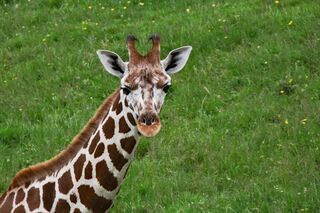Media
Is That Video Real—or CGI?
Social media scammers repurpose art as "news" to make you click.
Posted August 19, 2022 Reviewed by Ekua Hagan
Key points
- Fake photos and videos are not always created to mislead; the trickery may be in service of art or entertainment.
- Scammers may share this art—particularly if compelling, like unusual animal videos—as if it’s real to gain clicks, followers, and profit.
- Researchers are trying to develop automated ways to uncover what is sometimes called “fauxtography.”

On Twitter: A viral video of a group of turtles running—yes, running!—around and around in a circle, with the caption “Wait—turtles are fast?” Another viral video, also on Twitter, this time of a bunch of tiny baby giraffes galloping around a park with the caption, “Had no idea baby giraffes looked exactly like adult miniature giraffes but not sure what I expected.”
In both cases, the tweeted videos of unusual animal behavior went viral. And in both cases, the videos were fakes. Both had been computer-generated by the artist Vernon James Manlapaz. But Manlapaz did not create the videos to deceive anyone, just as the creators of the movie Jurassic Park had no intention of convincing anyone that genetics scientists could recreate dinosaurs that could then live in a theme park. The dinosaurs we saw on screen were, of course, computer-generated imagery and it was all made for entertainment.
Manlapaz works in the 3D animation business in Los Angeles and creates digital art on the side. He told a reporter, “My creative process usually starts by looking at my surroundings and asking myself, ‘What if?’ From there I get inspiration from games, movies, people, and life in general.”
His Instagram page, where he shares his video art, includes such fantastical tableaus as a school of multicolored tropical fish and a sea turtle swimming through the air at an amusement park, their sidewalk shadows trailing them; a battalion of two-foot-tall gummy bears bopping aimlessly in the aisle of a grocery store; and a baby rhino expertly riding a scooter alongside both a strolling adult rhino and a stream of people cycling through a park. Just a glance at Manlapaz’s Instagram makes it unmistakably clear that his elaborate work is not intended to deceive. Why, then, did his work lead to viral misinformation?
Profiting From Deception
Manlapaz’s videos, and others like them, were not created to intentionally mislead; however, people other than their creators often present these digital creations as real to attract social media followers—and make money—a tactic called h.
The news literacy newsletter The Sift described this tactic as “accounts seeking to build up large social media followings at all costs, even when it means passing off digital fakes as genuine.” The Sift points out that these social media users are aware that certain images, including “those that feature unusual or cute animals” are particularly likely to go viral.
Researchers, including Dimitrina Zlatkova and her colleagues (in a preprint), have referred to the phenomenon of misleading visuals as fauxtography, “images, especially news photographs, that convey a questionable, or outright false, sense of the events they seem to depict.” At the Misinformation Desk, we’ve written previously about nature photographs that went viral early in the pandemic—swans supposedly returning to a Venice devoid of tourists. But those were real photos that were misinterpreted. (They were real swans, but they were not in Venice.) We’ve also written about deepfakes—doctored photos or videos, including revenge porn. But deepfakes are typically created with nefarious goals in mind, what is often called malinformation.
With work like Manlapaz’s, though, we’re talking about a different kind of fake: photos or videos created solely as art or entertainment, like a dinosaur movie, with no goal to mislead—only to enchant or create wonder. As we noted previously, Manlapaz posts his work on his Instagram where it’s easy to see that he’s a digital creator crafting fanciful art. The misinformation comes later when a social media user co-opts Manlapaz’s art without his permission to trick viewers into clicking on and engaging with their fake articles in pursuit of profit.
Fighting Back Against Fauxtography
There are both programmatic and individual solutions to the proliferation of fauxtography and its video counterparts. One broad solution is expanded fact-checking of visuals. The efforts of groups like Oryx and Bellingcat to fact-check images related to the war in Ukraine is one particularly noteworthy example. Zlatkova and her colleagues observe that the problem of fake images and videos is too large to fact-check individually beyond a single domain (e.g., Ukraine war photos) and are working on strategies to automate the process. They have developed an open-source dataset using a variety of tools, including reverse-image searches, examination of features of the image such as Google tags, and an examination of existing databases, such as the Fauxtography section of the fact-checking website Snopes. These researchers plan to turn their attention to the fact-checking of videos next.
As an individual, you can also train yourself not to fall for this trick. The Sift suggests that you actively seek out “engagement bait” by going on Twitter and searching for “amazing nature” or “baby animals.” Try to notice when a clickbait-y photo seems too good to be true. Or, they suggest, check out, or even follow, Twitter accounts such as @HoaxEye and @PicPedant that find the engagement bait for you; you can then look for patterns in the deceiving photos and articles these sleuths post. Once you’re viewing visuals with a critical eye, if a photo raises suspicion, you can use some of the tools described earlier, like a reverse-image search, to do some sleuthing of your own. The cardinal rule: Always verify before sharing.
And, solely for entertainment, do check out the clever digital art on @vernbestintheworld, Manlapaz’s Instagram. We especially like the runaway oversized donut and the gargantuan porcupine, not least because they are just a bit too unbelievable to ever be turned into viral misinformation.
References
Zlatkova, D., Nakov, P., & Koychev, I. (2019). Fact-checking meets fauxtography: Verifying claims about images. https://arxiv.org/abs/1908.11722


